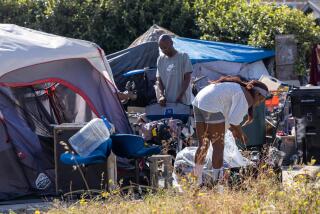Shelters Filled by Shivering Homeless : Weather: As icy cold weather grips the area, Los Angeles County is urged to keep its accommodations open continuously for 60 days. Activists call it a matter of life and death.
- Share via
While cold blustery winds swirled through Los Angeles on Thursday, lines for hot meals got longer on Skid Row, the free blankets were gone by midday, and downtown shelters were filled.
At the same time, a group of homeless activists launched a campaign to pressure Los Angeles County to keep its emergency shelters for the homeless open continuously for 60 days this month and early next year, rather than only on the coldest days.
“This is an issue of life and death. The bottom line is people need shelter,” said John F. Suggs, director of the Los Angeles Countywide Coalition for the Homeless, an umbrella organization of homeless advocacy groups.
The city of Los Angeles has already started keeping its 12 emergency shelters continuously open for 60 days.
The county’s emergency program goes into effect only when the National Weather Service predicts rain, or a nighttime temperature below 40 degrees. And county officials say they cannot afford to do more.
“It’s a matter of resources,” said Dawson Oppenheimer, spokesman for County Board of Supervisors Chairman Michael Antonovich. “We are right now facing drastic cuts in mental health and health budgets. . . . We are operating to the maximum of our capacity.”
The homeless coalition’s campaign includes an ad to air on local radio stations asking the public to call Antonovich and demand 60-day operation of the shelters.
According to Alan Wilkins, county homeless coordinator, the county uses $525,000 in federal funds to provide lodging for about 1,000 people at five California National Guard armories, a Salvation Army shelter in Bell, and church facilities in the San Gabriel Valley.
The county does not use any of its own funds. Suggs criticized this practice, noting that the city of Los Angeles contributes about $400,000 to its $1,032,000 emergency shelter program, with the balance paid with federal funds, and Santa Monica is paying more than $200,000 from its general funds for a cold-wet weather program.
Wilkins also noted that “we just don’t have the facilities” to expand, largely due to the county’s reliance on the armories. According to 3-year-old state guidelines, the military facilities can be used only on an emergency basis, based on the temperature criteria. National Guard officials also said 60 continuous days of use could interfere with units preparing to go to the Persian Gulf.
Replacing the armories, Wilkins estimated, would cost the county program “$1.5 (million) to $2 million more.”
The county shelter program, however, has been in effect countywide for the last six days, including Thursday, with an average 600 of the available 1,000 beds used, Wilkins said.
Between 700 and 800 people each night this week have been staying at city shelters, which are providing 1,042 beds in the downtown area, Hollywood, San Pedro, West Los Angeles and Van Nuys, according to Priscilla Ortiz, assistant coordinator of the city’s cold-wet weather program.
In the Valley, 107 people sought refuge Wednesday night in a shelter at an armory in Van Nuys. But starting tonight, the shelter will be in a heated airplane hangar at Van Nuys Airport.
According to the county coroner’s office, one possible cold-related death occurred Dec. 14 when police found the body of an unidentified man, about 60 years old, outdoors in downtown Los Angeles. An autopsy is pending to determine whether natural causes or hypothermia was to blame, spokesman Bob Dambacker said.
Meanwhile, downtown missions said their beds have been full for months, so the cold snap has just “increased the number we turn down,” said Raymond McCann of the Union Rescue Mission on Main Street. But since the Skid Row mission is a pickup and drop-off point for the city’s emergency shelter program, about 400 extra people show up for breakfast, he added, “because they’re being dropped off here.”
Near Olvera Street, several homeless men said they had gone to shelters this week because, as Jose Ruiz, an unemployed laborer said, “It’s too cold, especially in the morning.”
More to Read
Sign up for Essential California
The most important California stories and recommendations in your inbox every morning.
You may occasionally receive promotional content from the Los Angeles Times.










